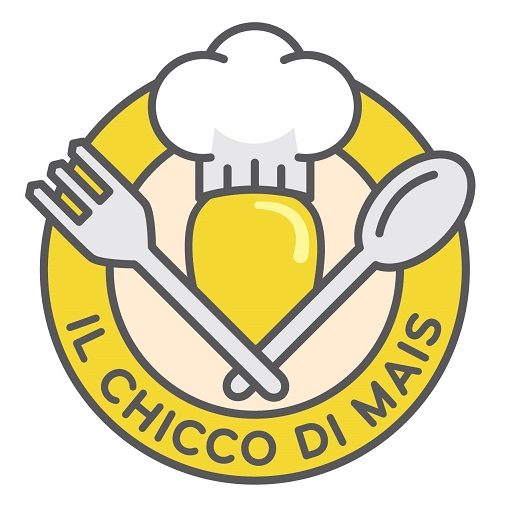Tuscan cuisine is renowned for its simplicity and authenticity, and panzanella is one of the dishes that best embodies these characteristics. This delightful summer salad based on stale bread is a very ancient recipe featuring some essential ingredients: Tuscan “sciocco” bread (meaning unsalted bread) soaked in water and vinegar, tomatoes, onion, and basil, with the addition of cucumber (or celery depending on the area); you can also add other elements to these basic ingredients of the Tuscan panzanella, which are not provided for in the original recipe but can make the dish richer and more nutritious (I talk about this more extensively at the end of the recipe).
A quintessentially poor dish, created with the aim of recovering stale bread, Tuscan panzanella is a timeless recipe that celebrates the authentic flavors and simplicity of Italian cuisine. With its mix of fresh and genuine ingredients, it is a perfect salad for hot summer days, also great to take to the beach or the office for lunch break.
You might also be interested in these recipes:
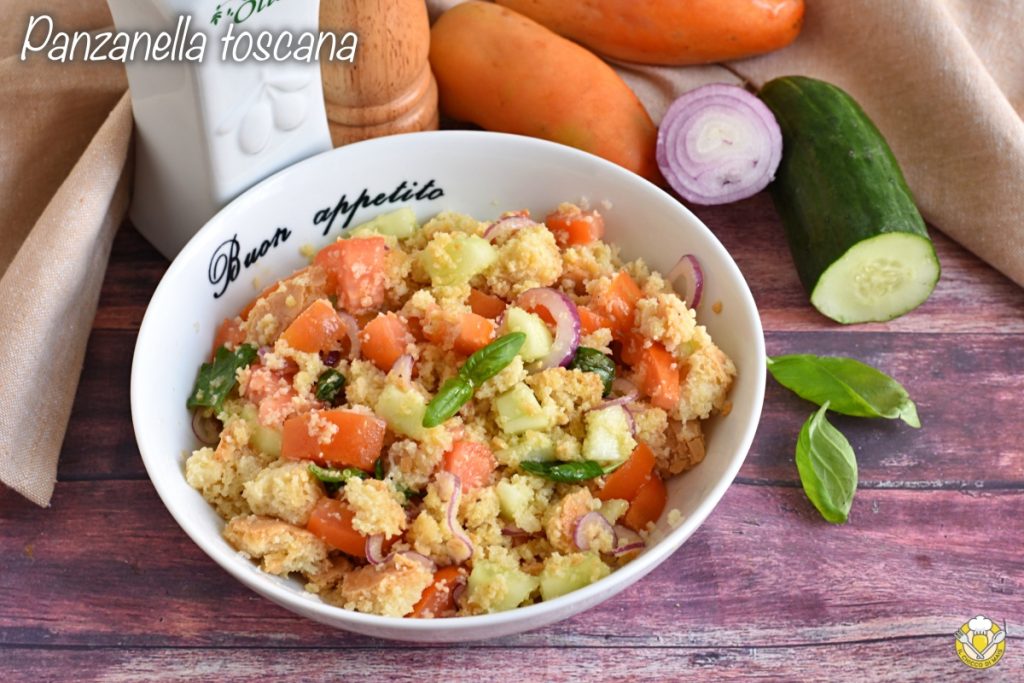
- Difficulty: Very Easy
- Cost: Very Cheap
- Rest time: 4 Hours
- Preparation time: 15 Minutes
- Portions: 4 servings
- Cooking methods: No Cooking
- Cuisine: Regional Italian
- Region: Tuscany
- Seasonality: Summer
Ingredients for traditional Tuscan panzanella
If you’re celiac, the recommendation is, if possible, to get fresh unsalted bread (you can make it at home with this recipe) and let it dry; if not, I advise against making Tuscan panzanella with packaged bread because it wouldn’t come out well, better to opt for croutons like these.
- 8.5 oz Tuscan bread (stale)
- 2/3 cup water (approximately)
- 2 tbsp vinegar
- 10.5 oz tomatoes
- 1 cucumber (approximately 3.5 oz)
- 1/2 red onion
- 6 leaves basil
- 4 tbsp extra virgin olive oil
- 2 pinches salt
- to taste pepper
Tools
- 1 Salad Bowl large
- 1 Chopping Board
- 1 Knife for bread
How to prepare Tuscan panzanella
 For the English version of this recipe click here!
For the English version of this recipe click here!
To prepare Tuscan panzanella, start by slicing the stale bread. Then cut it into cubes using your hands or a knife (1).
Place the bread in a bowl and wet it with about 2/3 cup of water (2) and 2 tbsp of vinegar. The amount of water and vinegar needed for panzanella varies and depends on two factors: 1) how dry the bread is: the drier it is, the more water will be needed 2) personal taste: some prefer that the panzanella remain a bit crunchier, others softer; for a milder flavor, you can also decrease the amount of vinegar.
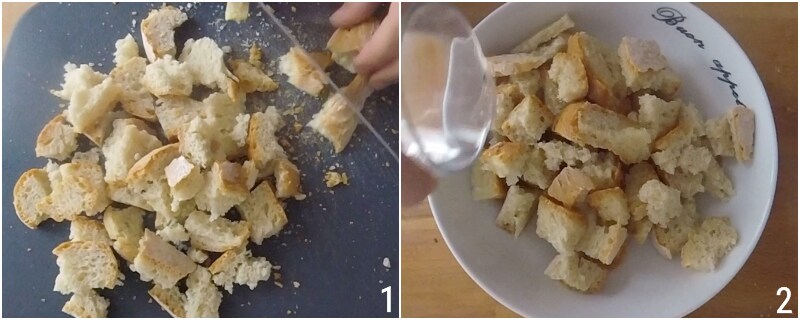
Consider that the panzanella should rest a few hours after it has been dressed and that tomatoes and cucumbers will release their juices and soften it further. Mix well with a spoon or with your hands to let the bread absorb the water and let it rest for about 30 minutes.
Meanwhile, prepare the vegetables: wash the tomatoes and cut them into cubes (3). Peel the cucumber and cut it into cubes as well (4).
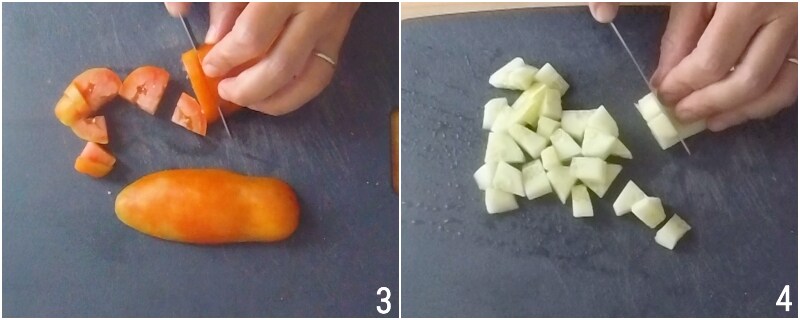
Slice the onion very thinly (5). Retrieve the bread and, if it is very wet, squeeze it a bit with your hands. Transfer it to a large salad bowl.
Add the tomatoes, cucumbers, onion, a good pinch of salt, and a grind of pepper. Complete with 4 generous tablespoons of extra virgin olive oil (6).

Mix carefully, then also add the basil leaves broken by hand (7). Mix again with a spoon, so that the ingredients blend perfectly (8).

Cover the salad bowl and let the Tuscan panzanella rest in the fridge for at least 4 hours before serving, so that the bread soaks well with all the flavors.
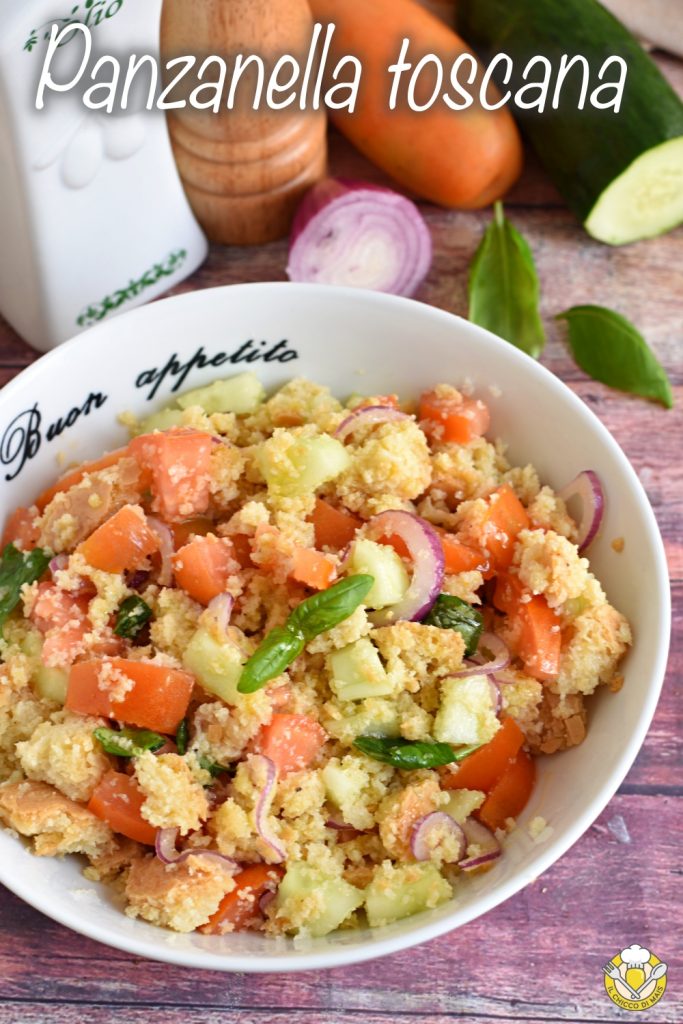
Storage
Panzanella can be stored in the refrigerator for up to 3 days.
Tips and Variations
What I have shown you is the traditional panzanella recipe, widespread in much of Tuscany; however, one should not forget that in some areas of the same region, instead of cucumber, celery is used, which should be sliced after being carefully cleaned.
Although the traditional recipe is always welcome, there are some variations of panzanella worth trying. For example, you can add capers, olives, or anchovies for an extra touch of flavor. Additionally, you can make panzanella a richer and heartier dish by adding canned tuna or mozzarella.
Curiosities
The word “panzanella” derives from the Tuscan word “panzana,” meaning bread, a staple of rural cuisine. Of course, it wasn’t thrown away when it became dry, but was reused to create new dishes, adding the products of the land that were available at that time. For this reason, when talking about recipes of rural tradition – another example, to stay in Tuscany, is ribollita – it makes little sense to try to trace the original recipe: each farmer used what they had at the time.
FAQ (Frequently Asked Questions)
What can I use instead of Tuscan bread for panzanella?
If you can’t find traditional Tuscan bread, use unsalted bread, which is common throughout central Italy. Otherwise, you can use rustic bread from your area.

